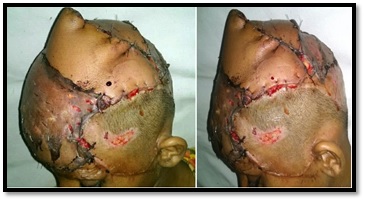Nitroglycerin transcutaneous patch: boon to salvaging post-operative partial flap necrosis, simple and effective method
Abstract
Introduction: The majority of surgical complications after tissue transfer surgery (Local transposition of the fasciocutaneous flap, Pedicle flap, Free flap or musculocutaneous flap) are related to vascular thrombosis, which usually occurs within 3 days of surgery. Venous congestion usually results in oedema and darkening of the skin colour. During early venous obstruction, a needle stick will cause rapid bleeding of dark blood and arterial obstruction or spasm will cause delayed bleeding. Application of nitroglycerine (NTG) patch in the congested area or ischemic area of the flap may improve the vascularity and clinical features of the flap. It salvages the failing flap or avoids an unnecessary surgical exploration of flaps.
Patients and methods: This is prospective study was carried out during the period from January 2018 to February 2021 at the Plastic surgery unit-Chirayu Medical College And Hospital Bhopal, India. This study included patients aged 13 to 70 years undergoing reconstructive surgery with flaps (Fasciocutaneous Pedicle flap, Free flap, local transposition flap or musculocutaneous flap) for the wounds at any part of the body. The NTG patch was applied over the cutaneous surface of the compromised flap and then flap insufficiency was observed. The NTG patch was changed in 12-14 hrs intervals daily. The follow-up was done and finally, the flaps were assessed at 1 week post-operatively.
Results: In this study total of 50 patients with flaps reconstruction were included. Among which 34 %( 17 patients) had skin changes and 66 % (33 patients) had congested bleed on needle prick. NTG patches were applied on the flap surface at regular intervals. After 1 week follows up, the changes in 82% (41) flaps were reversed back and the flap remained healthy. 18% (nine) flaps had partial and or complete necrosis. None of the patients experienced any complications (like dizziness, vertigo or fall of blood pressure) during the application of the NTG patch.
Conclusion: There was a marked reduction in partial flap necrosis in patients who received nitroglycerin patch. The flap survival was significantly improved and prevents the re-exploration of flaps. Their application is a simple, safe, and effective way to help salvage the flaps.
Downloads
References
B. C. D. Evans and G. R. D. Evans, “Microvascular Surgery,” Plastic & Reconstructive Surgery, Vol. 119, No. 2, 2007, pp. 18e-30e. http://dx.doi.org/10.1097/01.prs.0000246717.81077.e4
Spiegel JH, Polat JK. Microvascular flap reconstruction by otolaryngologists: prevalence, postoperative care, and monitoring techniques. Laryngoscope. 2007 Mar;117(3):485-90. doi: 10.1097/MLG.0b013e31802d6e66.
Chen Z, Foster MW, Zhang J, Mao L, Rockman HA, Kawamoto T, Kitagawa K,Nakayama KI, Hess DT, Stamler JS. An essential role for mitochondrial aldehyde dehydrogenase in nitroglycerin bioactivation. Proc Natl Acad Sci U S A. 2005 Aug 23;102(34):12159-64. doi: 10.1073/pnas.0503723102. Epub 2005 Aug 15.
Hidalgo DA, Disa JJ, Cordeiro PG, Hu QY. A review of 716 consecutive free flaps for oncologic surgical defects: refinement in donor-site selection and technique. Plast Reconstr Surg. 1998 Sep;102(3):722-32; discussion 733-4.
Askari M, Fisher C, Weniger FG, Bidic S, Lee WP. Anticoagulation therapy in microsurgery: a review. J Hand Surg Am. 2006 May-Jun;31(5):836-46. doi: 10.1016/j.jhsa.2006.02.023.
Miyasaka M, Ichikawa K, Nishimura M, Yamazaki A, Taira H, Imagawa K, Tanino R. Salvage operations of free tissue transfer following internal jugular venous thrombosis: a review of 4 cases. Microsurgery. 2005;25(3):191-5. doi: 10.1002/micr.20104.
Araco A, Gravante G, Araco F, Delogu D, Cervelli V. Conservative management of flap necrosis after expanding hematomas for face lifting surgery. Dermatol Surg. 2006 Jun;32(6):878-9; author reply 879-80. doi: 10.1111/j.1524-4725.2006.32183.x. PMID: 16792664.
Personelle J, Bolivar de Souza Pinto E, Ruiz RO. Injection of vitamin A acid, vitamin E, and vitamin C for treatment of tissue necrosis. Aesthetic Plast Surg. 1998 Jan-Feb;22(1):58-64. doi: 10.1007/s002669900167.
Jurczak F, Dugré T, Johnstone A, Offori T, Vujovic Z, Hollander D; AQUACEL Ag Surgical/Trauma Wound Study Group. Randomised clinical trial of Hydrofiber dressing with silver versus povidone-iodine gauze in the management of open surgical and traumatic wounds. Int Wound J. 2007 Mar;4(1):66-76. doi: 10.1111/j.1742-481X.2006.00276.x.
Kubo T, Yano K, Hosokawa K. Management of flaps with compromised venous outflow in head and neck microsurgical reconstruction. Microsurgery. 2002;22(8):391-5. doi: 10.1002/micr.10059.
Dabb RW, Malone JM, Leverett LC. The use of medicinal leeches in the salvage of flaps with venous congestion. Ann Plast Surg. 1992 Sep;29(3):250-6. doi: 10.1097/00000637-199209000-00010.
Burns A, Avery BS, Edge CJ. Survival of microvascular free flaps in head and neck surgery after early interruption of the vascular pedicle. Br J Oral Maxillofac Surg. 2005 Oct;43(5):426-7. doi: 10.1016/j.bjoms.2005.01.013.
Hyodo I, Nakayama B, Kato H, Hasegawa Y, Ogawa T, Terada A, Torii S. Analysis of salvage operation in head and neck microsurgical reconstruction. Laryngoscope. 2007 Feb;117(2):357-60. doi: 10.1097/mlg.0b013e3180312380.

Copyright (c) 2021 Author (s). Published by Siddharth Health Research and Social Welfare Society

This work is licensed under a Creative Commons Attribution 4.0 International License.


 OAI - Open Archives Initiative
OAI - Open Archives Initiative


















 Therapoid
Therapoid

